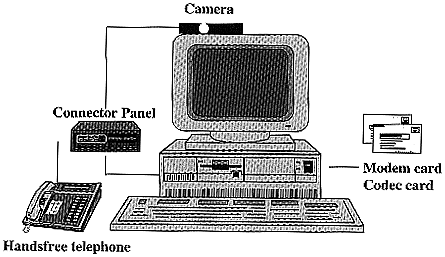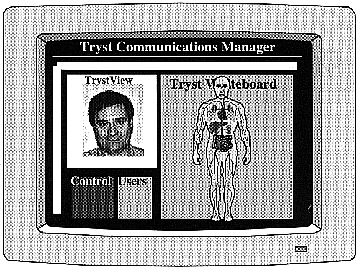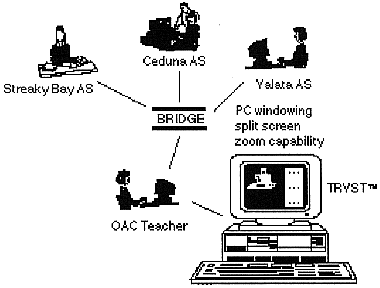[ EdTech'94 Contents ]
[ EdTech Confs ]
Curriculum delivery by desktop compressed video conferencing
Roger Edmonds
Open Access College
The Open Access College is in the early stages of managing a project trial of desktop compressed video conferencing to deliver its curriculum of distance education to school based students. While no formal evaluation has occurred, early indications suggest it is offering enhanced learning opportunities, enabling more group work and social interaction between students.
Open access education attempts to redress the educational disadvantage arising from isolation or remoteness expanding options available for both metropolitan and country students.
The practice of teaching students from a location remote from the student's home or school, commonly called 'distance education' is one practice available to open access and has been meeting the needs of isolated students in South Australia since 1919. The Open Access College (OAC) is the major centre for distance education delivery in South Australia. It comprises a:
- R-10 School of Distance Education;
- Senior Secondary School of Distance Education;
- School of the Air;
that together deliver the distance education curriculum to nearly 2000 students and:
- Materials Unit that produces high quality print, video, audio and electronic learning materials for the whole of the college and local delivery schools in South Australia;
- Outreach Education Service comprising educational officers located at public institutions like the zoo, museums, art gallery etc.
OAC students are very diverse in their nature and are both school based (ie students attending a face to face school but enrolled at the OAC for some subjects not offered by that school) and home based (ie students enrolled at the OAC that do not attend a face to face school for any subject). Almost half of the students we deliver to are home based, either being geographically remote from a school or isolated, eg medical disability, travel, vocational study (eg ballet student) or are referred to us from other authorities. Some may never have a regular supply of electricity.
Current delivery systems
In 1994 OAC learning materials are print based. They are supported by:
- video and audio tapes;
- kits of practical equipment;
- lesson delivery by telephone, teleconferencing or HF radio conferencing;
- facsimile;
- limited audiographic conferencing;
- limited computer assisted learning software.
Alternative delivery systems
Research on realistic options tor implementing technology into the delivery of the curriculum of distance education and its course materials began in 1993 and concluded that delivery technologies that are:
- available and accessible;
- acceptable to teachers, supervisors and students;
- economically viable;
- valid or appropriate for the objectives and content of the course;
then successfully integrated into the instructional design of our materials can enhance learning opportunities by:
- enabling subject content to be learnt quicker and at a higher level;
- improving communication and information handling skills;
- improving skills associated with cooperative and collaborative learning.
The research recommended that the OAC implement pilot projects using:
- computer mediated communication using email and Electronic Classroom
- compressed video conferencing;
This paper reports on the early implementation phase of the desktop compressed video conferencing pilot project.
Desktop compressed video conferencing
Background
The OAC prepared a submission with the Targeted Populations Unit to fund a proposal under the Country Areas National Component that aims to ensure equitable and coordinated access to a wide variety of learning options for isolated and rural students.
The project of curriculum delivery by desktop compressed video conferencing is between four schools in SA. The technology will allow senior students access to real time video conferencing on a multi-functional computing platform.
Outcomes of the project
- Enhanced learning opportunities for concepts and processes that are difficult to teach in the non-visual mode or where limited movement video input is needed.
- More interaction and group work.
- A more realistic and wider choice in a post compulsory curriculum.
- More meaningful teacher-student interaction.
- Supervisors will have a means to video conference with other supervisors and teachers.
The technology
Desktop compressed video conferencing incorporates videophone technology on a computer. Teachers and students can make a desktop videophone call where they simultaneously talk on the phone, see each other and interactively share/edit computer documents all over one public telephone line. The cost of making a video/multimedia call and making a normal phone call are exactly the same.
The unit called a TRYST comprises a camera, codec, modem, handset/speaker phone, PC board and software (Figure 1). It will be installed on a 486DX33 computer. Other audiovisual equipment eg an external video camera, facsimile etc can be attached to the computer video conferencing workstation.

Figure 1: The TRYST video conferencing hardware
Point to multipoint video conferencing will be possible through a multiple control unit or bridge at much higher costs. The TRYST screen (Figure 2) will have a view window that can be adjusted in size, an interactive whiteboard and/or space to view an application a set of graphic manipulation tools and user/control panels.

Figure 2: The TRYST screen
The role of compressed video conferencing in distance education
Very little research has been published on teaching/learning methodology using desktop compressed video conferencing. We are pioneering the field.
TRYST video conferencing will add a social presence to distance education teaching and allow students and teachers to share applications by passing the keyboard and to share interactive whiteboards. Images can be still framed. The video images are jerky and not natural and it is not possible to synchronise lip movement with sound. Sound from musical instruments can not be transmitted without distortion either.
The teachers and students involved in the trial will be participating in a comprehensive training and development program to learn about the strengths and limitations of the equipment and the instructional design of the online environment so they can begin to feel comfortable with the technology. There will also be time for teachers to prepare materials for delivery.
A typical scenario showing the potential of compressed video conferencing
Physics is being delivered from the OAC to students in the pilot trial (Figure 3). The teacher uses an external video camera at the OAC to show the other schools the equipment needed for their next practical, how to get it to assembled so it can work properly then shows how they might use a spreadsheet to record their experimental data. Students at these schools have this practical equipment in their kits and can easily identify each component as they see it on their computer monitor. The teacher makes recommendations on how to use each piece of equipment and delegates responsibilities to each school recording the experiment viz.
- school A to use video camera to record their experiment.
- school B to record experiment results in a spreadsheet form.
- school C to write a conclusion using a word processor and sketch the equipment using a graphics drawing application.

Figure 3: Desktop video conferencing lesson using TRYST technology
Next week the students at the three schools display their collaborative recording of the experiment to each other on their desktop video conferencing hardware.
This project trial will commence in July, 1994.
Conclusion
We remain in the early to middle stages of implementing new technology into the delivery of our curriculum. We have completed a front end analysis and are embarking on small scale implementation through the pilot projects we will manage during 1994. We are some way towards the OAC as an organisation adopting the new technologies and large scale institutionalisation of them. The future looks challenging and very exciting.
| Author: Roger Edmonds, Project Officer, Alternative Delivery Systems, Open Access College, Locked Bag No. 1, Marden 5070; Telephone: +61 8 366 0478; Fax: +61 8 362 0045; Email: redmonds (Nexus). During 1993, Roger Edmonds was a research officer at the Open Access College, a DE&CS school that delivers a curriculum of distance education to nearly 2000 school based and home based students from K-13 in South Australia, interstate and overseas. During this time he conducted research on realistic options for implementing technology into the delivery of the curriculum and the development of course material packages. In 1994 Roger is a Project Officer for Alternative Delivery Strategies and is managing two pilot projects at the Open Access College: curriculum delivery by compressed video conferencing and curriculum delivery by email and Electronic Classroom.
Please cite as: Edmonds, R. (1994). Curriculum delivery by desktop compressed video conferencing. In J. Steele and J. G. Hedberg (eds), Learning Environment Technology: Selected papers from LETA 94, 63-65. Canberra: AJET Publications. http://www.aset.org.au/confs/edtech94/ak/edmonds.html |
[ EdTech'94 contents ]
[ ASET Confs ]
This URL: http://www.aset.org.au/confs/edtech94/ak/edmonds.html
Last revised 27 May 2003. HTML editor: Roger Atkinson
Previous URL 16 May 1999 to 30 Sep 2002: http://cleo.murdoch.edu.au/aset/confs/edtech94/ak/edmonds.html




